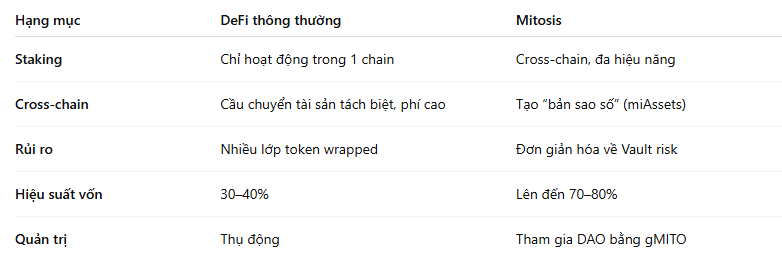I don't remember exactly when I first learned about @Mitosis Official but I must admit that this project has completely changed my perspective on the efficiency of capital use in DeFi.
Before encountering Mitosis, I, like many other DeFi users, had assets 'stuck' in individual chains:
ETH was staked on Ethereum,
USDC was farming on Arbitrum,
while MATIC was sitting idle in the Polygon wallet, not generating any returns.
The result is low capital efficiency, averaging only 5–15%/year despite facing various transaction costs and cross-chain risks.
🧩 The Problem of Traditional DeFi: Capital is Not Really 'Free'
In today's DeFi, users are still limited by the model of 'one asset – one position – one chain'.
This leads to:
Capital is fragmented, unable to be reused flexibly.
Transaction costs (especially gas fees when cross-chain) become a barrier.
Profit opportunities are missed when high yields appear on other chains.
I often had to wait until midnight to 'watch for low gas' before daring to transfer assets – it really felt bad.
⚙️ Mitosis Emerges: When Liquidity Becomes 'Programmable'
What impressed me from the beginning was the philosophy of 'Programmable Liquidity' – liquidity that can be programmed.
Instead of simply 'transferring' assets across the cross-chain bridge, Mitosis creates a representative version (miAssets) for each asset deposited into the multi-chain vault.
For example, I deposit ETH and USDC into Mitosis → receive miETH and miUSDC, two tokens representing 1:1 with the original assets.
The interesting thing is that these miAssets can operate simultaneously on multiple chains – without needing to transfer back and forth.
🔁 My Real-Life Experience
Step 1: Deposit Assets & Receive miAssets
I deposit ETH and USDC into Mitosis's Vault, immediately receiving miETH and miUSDC – no waiting, no high fees.
Step 2: Multi-Chain – Multi-Strategy
I break down miAssets to maximize:
On Arbitrum: farming with Theo Protocol.
On Ethereum: participating in lending at Morph.
On Optimism: providing liquidity for the stable pool.
In just a few clicks, I turn one unit of base assets into three parallel income streams, without spending gas to move across chains.
Step 3: Stake MITO & Participate in Governance
The amount of MITO received from the rewards I stake continues to earn gMITO, from which I participate in DAO governance.
This allows me not only to 'invest' but also to have a say in directing the liquidity fund of the protocol – it feels like becoming a part of the true DeFi infrastructure.
📈 Three Significant Improvements After One Month
1. Capital efficiency increases dramatically
Thanks to the 'multi-chain usage' capability, the same capital can now create multiple layers of profit.
The average APY increased from 12% → over 35%, with some strategies achieving 300% capital efficiency compared to the traditional model.
2. Gas fees are almost zero
The batch bridge + dynamic subsidy + fee sharing mechanism helps reduce cross-chain costs to only $0.01/transaction.
After the sixth time, Mitosis further reduced fees by 50% for active users – something that no protocol in the cross-chain space has achieved.
3. Strongly reduce opportunity costs
I can immediately take part in new yield opportunities without having to 'wait to transfer chains'.
This flexibility allows me to seize many arbitrage and yield opportunities during short market fluctuations.
💡 EOL Mechanism: Keep Liquidity Stable Like the Protocol's Assets
What I value most in Mitosis is the EOL (Ecosystem-Owned Liquidity) mechanism.
The DAO directly owns and manages most of the liquidity – this:
Minimize 'farm & dump'.
Keep liquidity pools stable, avoiding shocks when whales withdraw funds.
Bring sustainability for long-term yields.
⚖️ Comparison with Traditional DeFi

🚀 From 'Holding Assets' to 'Holding Liquidity Rights'
What I learned after experiencing Mitosis is not only how to optimize profits but also to change the mindset about capital.
My assets are no longer just numbers 'lying still' in the wallet – but a vibrant liquidity network, moving freely between chains, creating continuous value.
That is true DeFi:
"Not just owning assets – but owning the ability to move and use assets anywhere."
🌐 Looking Further: Mitosis and the Era of DeFi 2.0
As Mitosis expands support for more blockchains and develops a multi-layer risk management system, I believe it will become the core infrastructure of DeFi 2.0, just as TCP/IP is for the Internet.
This is not just a protocol – but a new standard for global liquidity.
✍️ Conclusion
After a month of staking and experience, I believe that Mitosis not only enhances capital efficiency, but is also redefining how DeFi operates:
From locked assets → programmable liquidity.
From yield chasing → sustainable yield.
From fragmented assets → unified liquidity.
Mitosis made me realize that in the DeFi world, 'free capital' is the real power.

